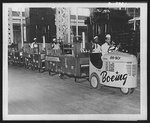- Thread starter
- #21
syscom3
Pacific Historian
I think the reason the car makers could build engines so fast, is they knew how to do it. Consider they had to make as many car engines in a week as the aircraft engine makers could expect to build in a year.
Ok, heres the next part of Chrysler/Dodge effort for the B29
B-29 Combat Deployment Begins
On their way to initial deployment in India/China, the B-29s were subjected to ground temperatures in the sun that were regularly well over 120 degrees F. Temperatures reached nearly 200 degrees inside planes--with some engines only about 20 degrees from overheating even before firing up. Detonation was a severe problem directly affecting valve life. Parts change kits were rushed out to numerous locations to speed the planes to their destination. Teams fanned out to wherever B-29s were in the pipeline--to make the necessary alterations and keep the program momentum alive!
Conditions in China were so primitive that fuel had to be flown in over the Himalayas, slowly building up enough gasoline and bombs to eventually launch the first group of strikes. These missions were flown at high altitudes, dropping high-explosive bombs. A number of the trips were actually regarded as training of the most serious kind. The professionalism of the Americans dedicated to those early moves is awesome to contemplate. Moreover, all airfields in China were constructed by thousands of Chinese people using hand labor and tools of the most rudimentary kind.
Dodge-built B-29 Engines Enter Combat
Perhaps the greatest compliment to Dodge-Chicago performance was that, at the outset, their engines were used interchangeably with Wright's production. As the program progressed, Dodge provided the vast majority of the engines: 18,413 for 3,628 B- 29s, or just over five engines per plane!
After General LeMay took command in January, 1945, he re-structured the maintenance program, based on his European experience. Soon, flying reached a tremendous 120 hours per plane per month and mission action swung into high gear. During their 1944 and 1945 service against Japan, they dropped 169,676 tons of bombs, adding another 167,000 tons during the three years of the Korean War (by which time they normally required a heavy fighter escort due to the advent of jet fighters). Actual bombing runs after arrival at the target were carried out at 210 mph (LeMay and Yenne, p. 150).
Dodge Achieves Amazing Cost Savings Of Fifty Percent
On a per unit basis, Dodge-Chicago was able to reduce the cost of producing each engine from $25,314 plus a fee of $1,519 to $11,537 (fee, $580) and $12,954 for the fuel-injected version, all while incorporating 6,427 engineering changes! Overall, Dodge brought to completion 18,413 engines at about half of the estimated program costs, very much the same pattern achieved by Chrysler Corporation in all its war efforts. Seldom have the economic benefits of complete tooling, accurate drawings, dedicated leadership, well-trained employees, and a clear set of goals done as well. For perspective, consider that a brand-new Dodge 1942 D22 Custom four-door sedan delivered for $1,048 (Lee, p. 262).
Ok, heres the next part of Chrysler/Dodge effort for the B29
B-29 Combat Deployment Begins
On their way to initial deployment in India/China, the B-29s were subjected to ground temperatures in the sun that were regularly well over 120 degrees F. Temperatures reached nearly 200 degrees inside planes--with some engines only about 20 degrees from overheating even before firing up. Detonation was a severe problem directly affecting valve life. Parts change kits were rushed out to numerous locations to speed the planes to their destination. Teams fanned out to wherever B-29s were in the pipeline--to make the necessary alterations and keep the program momentum alive!
Conditions in China were so primitive that fuel had to be flown in over the Himalayas, slowly building up enough gasoline and bombs to eventually launch the first group of strikes. These missions were flown at high altitudes, dropping high-explosive bombs. A number of the trips were actually regarded as training of the most serious kind. The professionalism of the Americans dedicated to those early moves is awesome to contemplate. Moreover, all airfields in China were constructed by thousands of Chinese people using hand labor and tools of the most rudimentary kind.
Dodge-built B-29 Engines Enter Combat
Perhaps the greatest compliment to Dodge-Chicago performance was that, at the outset, their engines were used interchangeably with Wright's production. As the program progressed, Dodge provided the vast majority of the engines: 18,413 for 3,628 B- 29s, or just over five engines per plane!
After General LeMay took command in January, 1945, he re-structured the maintenance program, based on his European experience. Soon, flying reached a tremendous 120 hours per plane per month and mission action swung into high gear. During their 1944 and 1945 service against Japan, they dropped 169,676 tons of bombs, adding another 167,000 tons during the three years of the Korean War (by which time they normally required a heavy fighter escort due to the advent of jet fighters). Actual bombing runs after arrival at the target were carried out at 210 mph (LeMay and Yenne, p. 150).
Dodge Achieves Amazing Cost Savings Of Fifty Percent
On a per unit basis, Dodge-Chicago was able to reduce the cost of producing each engine from $25,314 plus a fee of $1,519 to $11,537 (fee, $580) and $12,954 for the fuel-injected version, all while incorporating 6,427 engineering changes! Overall, Dodge brought to completion 18,413 engines at about half of the estimated program costs, very much the same pattern achieved by Chrysler Corporation in all its war efforts. Seldom have the economic benefits of complete tooling, accurate drawings, dedicated leadership, well-trained employees, and a clear set of goals done as well. For perspective, consider that a brand-new Dodge 1942 D22 Custom four-door sedan delivered for $1,048 (Lee, p. 262).

